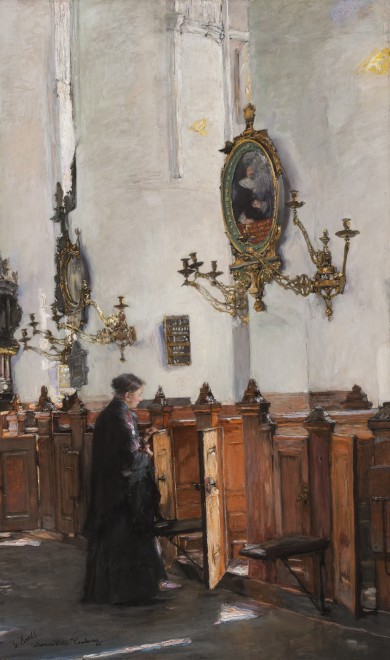Provenance
Gustave Poser, Dresden;
Private Collection, Dresden, 1956;
sale Arnold, Frankfurt, November 23. 2002, no. 783;
sale Lempertz, Cologne, May 21, 2005, no. 1114;
Private Collection, Bavaria.
Exhibitions
Grossen Kunstaustellung, Kunsthalle Hamburg and der Akademischen Kunst-Austellung, Dresden, 1895.
Literature
Uta Neidhardt, “Werkverzeichnis,” in Gotthardt Kuehl, 1850-1915 , Dresden and Leipzig, 1993, p. 200, no. 225.
One of the leading German Impressionists, Kuehl (fig. 1) was born in Lübeck, studied painting
first in Munich and then went to Paris in 1879. He remained there until 1889 absorbing the
Impressionist methods and exhibiting at the annual Salons. He was also much taken with the 17th century Dutch painters, like Vermeer and de Hooch, who were then becoming fashionable in
France. His work was appreciated there, winning him various medals and appointment as a
Chevalier and eventually an Officier of the Légion d’Honneur. When he returned to Germany, he
spent time in Munich and Dresden, extending his reputation as both a genre painter (fig. 2) and
specialist in architectural interiors, especially of churches (fig. 3). In this, as well as his free style
and taste for the anecdotal, Kuehl owed a debt to the famous older German painter Adolphe
Menzel (fig. 4).
While residing in Munich in the fall of 1890, Kuehl received an invitation from the progressive
director of the Hamburg Kunsthalle, Alfred Lichtwark, to visit his city and paint some views for
the “Collection of Pictures of Hamburg” he was compiling.1 As Lichtwark wrote to his friend, the
other chief German Impressionist painter, Max Liebermann, the church leaders of Hamburg were
eager to have picturesque interiors done of their old churches.2 Kuehl, as the museum director
found, was most amenable,3 and for this project he produced interior views of several Hamburg
churches: an oil view of the interior of St. Michael’s (fig. 5), a pastel of St. Jacobi’s (fig 6), and of
St. Catherine’s, both a pastel (fig. 7) and this identical oil on panel. The pastel version entered the
collection of the Hamburg Kunsthalle,4 but this larger oil version remained in private hands.
Kuehl, as in his similar view of the Interior of St. Jacobi’s Church , chose not to show the main
vista of the St. Catherine’s Church but rather one of the side naves. Against the sober,
whitewashed walls, the gilt candlesticks and framed portraits provide a center point of attention.
An elderly woman dressed in black slowly makes her way to one of the open pew doors, a detail
also repeated in the interior view of St. Michael’s. This painting of St. Catherine’s is a charming,
anecdotal Impressionist rendering of the interior, which captures a sense of spiritual devotion. But
what animates it is the sunlight illuminating the space and reflecting boldly in golden spots on the
wall. Kuehl employs a rich impasto to create texture and movement. Despite changes caused by
two World Wars, the interior is still recognizable today (fig. 8).
Kuehl was to continue painting church interiors into the next century (figs. 9a-b). While his work
is known in Germany,5 he is not well represented in America. His only painting in a museum here
is apparently the 1891 Wine Room (fig. 10) that entered the Philadelphia Museum of Art as part of
the bequest of John G. Johnson in 1917.6 A church genre scene by Kuehl was exhibited at both the
1893 World’s Columbian Exposition in Chicago and the 1904 Universal Exposition at St. Louis with the title A Mighty Fortress is Our God . (fig. 11).7
